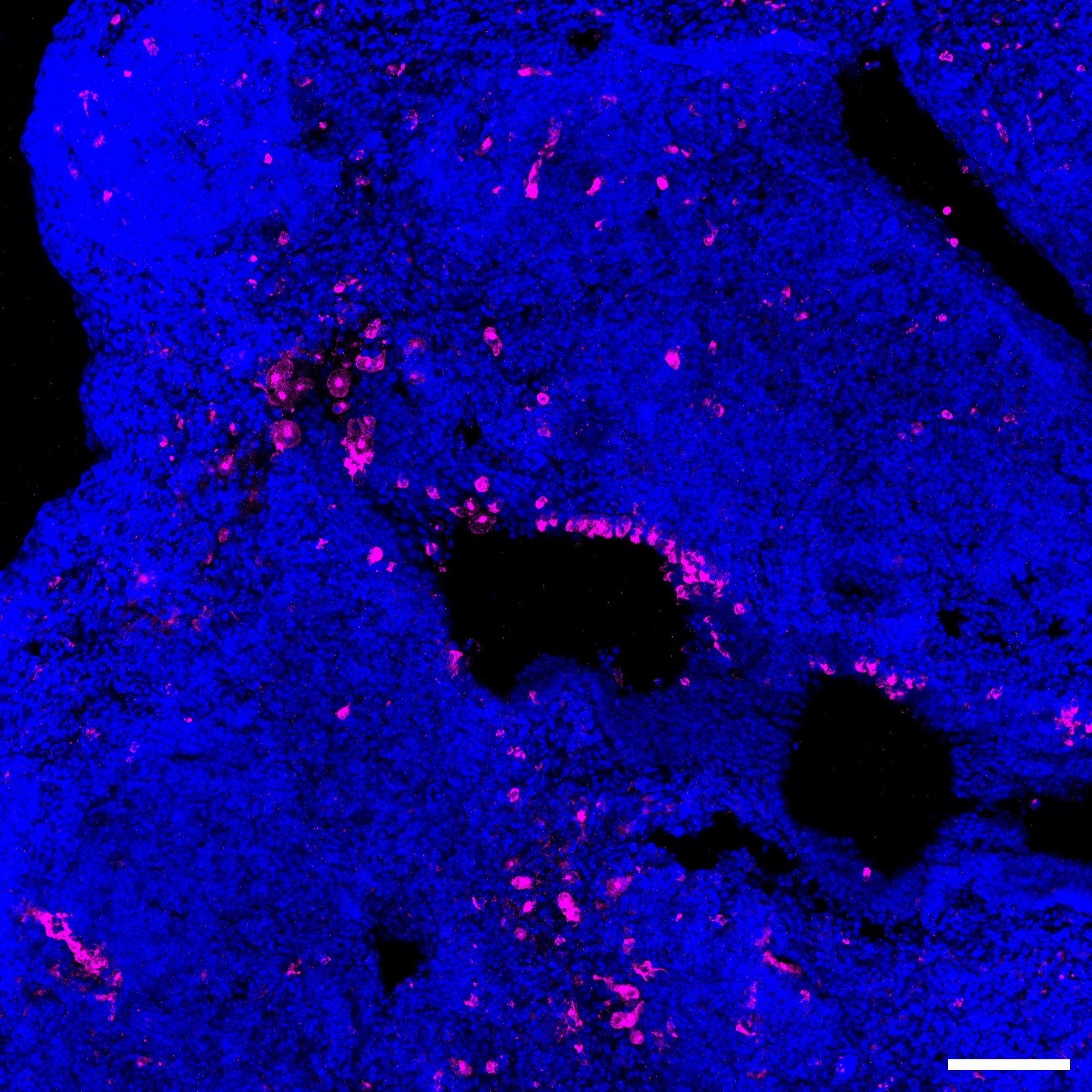Mouse CCL9/10/MIP-1 gamma Antibody Summary
Gln22-Gln122
Accession # Q3U9T8
Applications
Please Note: Optimal dilutions should be determined by each laboratory for each application. General Protocols are available in the Technical Information section on our website.
Scientific Data
 View Larger
View Larger
Chemotaxis Induced by CCL9/10/MIP‑1 gamma and Neutral-ization by Mouse CCL9/10/MIP‑1 gamma Antibody. Recombinant Mouse CCL9/10/MIP-1 gamma (Catalog # 463-MG) chemoattracts the BaF3 mouse pro-B cell line transfected with human CCR1 in a dose-dependent manner (orange line). The amount of cells that migrated through to the lower chemotaxis chamber was measured by Resazurin (Catalog # AR002). Chemotaxis elicited by Recombinant Mouse CCL9/10/MIP-1 gamma (40 ng/mL) is neutralized (green line) by increasing concentrations of Goat Anti-Mouse CCL9/10/ MIP-1 gamma Antigen Affinity-purified Polyclonal Antibody (Catalog # AF463). The ND50 is typically 0.3-1.0 µg/mL.
Preparation and Storage
- 12 months from date of receipt, -20 to -70 °C as supplied.
- 1 month, 2 to 8 °C under sterile conditions after reconstitution.
- 6 months, -20 to -70 °C under sterile conditions after reconstitution.
Background: CCL9/10/MIP-1 gamma
Mouse CCL9/10 (also named MIP-1 gamma and MRP-2) is an 11 kDa, secreted, monomeric polypeptide that belongs to the beta (or CC) intercrine family of chemokines (1‑3). Based on its activity and amino acid (aa) sequence, it is further classified as a member of the NC6 or six cysteine-containing CC subfamily of chemokines (2, 4, 5). This subfamily contains four N-terminally extended chemokines, two human (CCL15 and CCL23) and two mouse (CCL9 and CCL10). Within this subfamily, there are no human-to-rodent interspecies orthologs. Mouse CCL9/10 is synthesized as a 122 aa precursor that contains a 21 aa signal sequence and a 101 aa mature region with six cysteines. As noted, the mature region has an expanded N-terminus relative to other CC family members, and it forms a third intrachain disulfide bond with its two extra cysteines (3‑7). Mouse CCL9/10 is 75% aa identical to rat CCL9/10 (8). Chemokines are known to undergo proteolytic processing to generate multiple isoforms. NC6 chemokines are usually only marginally active at full length, but are converted to highly active forms upon N-terminal truncation. Mature CCL9, in the presence of inflammatory fluids, is naturally truncated by 28, 29 or 30 aa at the N-terminus, generating a highly active, 8 kDa, 71‑73 aa CCR1 ligand. In contrast, other CCR1 ligands, CCL3/MIP-1 alpha and CCL5/RANTES, lose their potency when proteolytically processed. CCL9/10 is constitutively secreted, and circulates as a full‑length molecule. Any onset of inflammation with subsequent enzyme release may act on local NC6 chemokines, generating early, potent leukocyte chemoattractants (5, 7).
- Zlotnik, A. and O. Yoshie (2000) Immunity 12:121.
- Zlotnik, A. et al. (1999) Crit. Rev. Immunol. 19:1
- Mohamadzadeh, M. et al. (1996) J. Immunol. 156:3102.
- Haelens, A. et al. (1996) Immunobiology 195:499.
- Berahovich, R.D. et al. (2005) J. Immunol. 174:7341.
- Youn, B-S. et al. (1995) J. Immunol. 155:2661.
- Poltorak, A.N. et al. (1995) J. Inflamm. 45:207.
Product Datasheets
Citations for Mouse CCL9/10/MIP-1 gamma Antibody
R&D Systems personnel manually curate a database that contains references using R&D Systems products. The data collected includes not only links to publications in PubMed, but also provides information about sample types, species, and experimental conditions.
5
Citations: Showing 1 - 5
Filter your results:
Filter by:
-
Pharmacological Modulation of the MIP-1 Family and Their Receptors Reduces Neuropathic Pain Symptoms and Influences Morphine Analgesia: Evidence from a Mouse Model
Authors: Ciechanowska, A;Pawlik, K;Ciapa?a, K;Mika, J;
Brain sciences
Species: Mouse
Sample Types: In Vivo
Applications: In Vivo -
Chemokine CXCL16 mediates acinar cell necrosis in cerulein induced acute pancreatitis in mice
Authors: Y Sakuma, Y Kodama, T Eguchi, N Uza, Y Tsuji, M Shiokawa, T Maruno, K Kuriyama, Y Nishikawa, Y Yamauchi, M Tsuda, T Ueda, T Matsumori, T Morita, T Tomono, N Kakiuchi, A Mima, Y Sogabe, S Marui, T Kuwada, A Okada, T Watanabe, H Nakase, T Chiba, H Seno
Sci Rep, 2018-06-11;8(1):8829.
Species: Mouse
Sample Types: Whole Tissue
Applications: IHC-Fr -
Changes in gene expression of pial vessels of the blood brain barrier during murine neurocysticercosis.
Authors: Mishra, Pramod K, Teale, Judy M
PLoS Negl Trop Dis, 2013-03-14;7(3):e2099.
Species: Mouse
Sample Types: Whole Tissue
Applications: IHC -
Comprehensive assessment of chemokine expression profiles by flow cytometry.
Authors: Eberlein J, Nguyen TT, Victorino F, Golden-Mason L, Rosen HR, Homann D
J. Clin. Invest., 2010-02-08;120(3):907-23.
Species: Mouse
Sample Types: Whole Cells
Applications: Flow Cytometry -
Myc CoopeRates with Ras by Programming Inflammation and Immune Suppression.
Authors: Kortlever Roderik M, Sodir Nicole M, Wilson Catherine H et al.
Cell
FAQs
No product specific FAQs exist for this product, however you may
View all Antibody FAQsReviews for Mouse CCL9/10/MIP-1 gamma Antibody
Average Rating: 5 (Based on 1 Review)
Have you used Mouse CCL9/10/MIP-1 gamma Antibody?
Submit a review and receive an Amazon gift card.
$25/€18/£15/$25CAN/¥75 Yuan/¥2500 Yen for a review with an image
$10/€7/£6/$10 CAD/¥70 Yuan/¥1110 Yen for a review without an image
Filter by:

